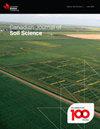农田土壤物理性质与水、盐、氮、磷含量的时空变异
IF 1.5
4区 农林科学
Q4 SOIL SCIENCE
引用次数: 0
摘要
土壤水分、盐分和养分变异性是影响农业系统作物生产力的重要因素。然而,小型农场的有效管理需要获得土壤水分、盐分和养分的精细数据。使用经典统计学和地统计学方法对空间变异性进行大规模评估,可以帮助确定营养缺乏区。在中国新疆,水和养分管理不足导致农业系统的作物生产力低下。为了解决这一问题,本研究评估了新疆地区农田土壤的机械组成、容重以及土壤中水、盐、铵态氮(NH4+-N)、硝态氮(NO3--N)和有效磷(A-P)的含量。结果表明,土壤容重变异性低,土壤含水量、机械组成、NO3--N和A-P变异性中等,土壤含盐量和NH4+-N变异性高。不同土层的力学成分和A-P变化幅度较小,表层土壤含水量和NO3-N的变化明显大于其他土层。NH4+-N变异性随土壤深度的增加而增加。随着时间的推移,土壤特性显示出最小的差异。在整个研究区域观察到多因素缺乏,特别是氮缺乏。生成的地图为农场管理者和决策者提供了一个有用的工具。总之,这项研究强调了评估土壤性质的空间变异性对于识别缺水和营养不良地区以及盐分积累地区的重要性。这些信息可用于制定针对特定地点的营养管理的有效策略。本文章由计算机程序翻译,如有差异,请以英文原文为准。
Spatiotemporal Variability of Soil Physical Properties and Water, Salt, Nitrogen, Phosphorus Contents for Farm level
Soil water, salt, and nutrient variability are essential factors that impact crop productivity in agriculture systems. However, effective management of small farms requires access to fine-scale data on soil water, salt, and nutrients. Large-scale assessments of spatial variability using classical statistics and geostatistical methods can help identify nutrient-deficient zones. In Xinjiang, China, inadequate water and nutrient management has resulted in low crop productivity in agriculture systems. To address this issue, this study evaluated the mechanical composition, bulk density, and contents of water, salt, ammonium nitrogen (NH4+-N), nitrate nitrogen (NO3--N), and available phosphorus (A-P) in soil at the farm level in the Xinjiang region. Results showed low variability in soil bulk density, medium variability in soil water content, mechanical composition, NO3--N, and A-P, and high variability in soil salt content and NH4+-N. Mechanical composition and A-P showed a small range of variation across different soil depths, while soil water content and NO3--N in the surface layer varied significantly more than in other soil layers. NH4+-N variability increased with soil depth. Soil properties showed minimal differences over time. Multi-factor deficiencies, particularly in nitrogen, were observed throughout the study area. The generated maps offer a useful tool for farm managers and policymakers. In summary, this study highlights the significance of evaluating the spatial variability of soil properties for identifying zones deficient in water and nutrients, as well as those with salt accumulation. This information can be utilized to develop effective strategies for site-specific nutrient management.
求助全文
通过发布文献求助,成功后即可免费获取论文全文。
去求助
来源期刊

Canadian Journal of Soil Science
农林科学-土壤科学
CiteScore
2.90
自引率
11.80%
发文量
73
审稿时长
6.0 months
期刊介绍:
The Canadian Journal of Soil Science is an international peer-reviewed journal published in cooperation with the Canadian Society of Soil Science. The journal publishes original research on the use, management, structure and development of soils and draws from the disciplines of soil science, agrometeorology, ecology, agricultural engineering, environmental science, hydrology, forestry, geology, geography and climatology. Research is published in a number of topic sections including: agrometeorology; ecology, biological processes and plant interactions; composition and chemical processes; physical processes and interfaces; genesis, landscape processes and relationships; contamination and environmental stewardship; and management for agricultural, forestry and urban uses.
 求助内容:
求助内容: 应助结果提醒方式:
应助结果提醒方式:


